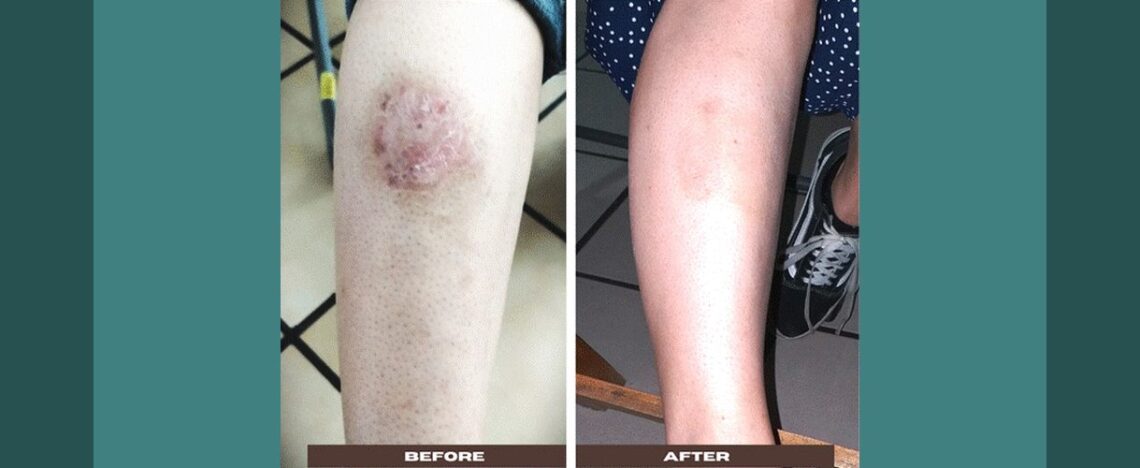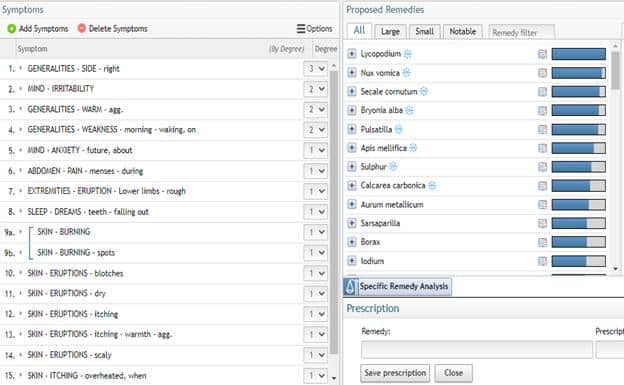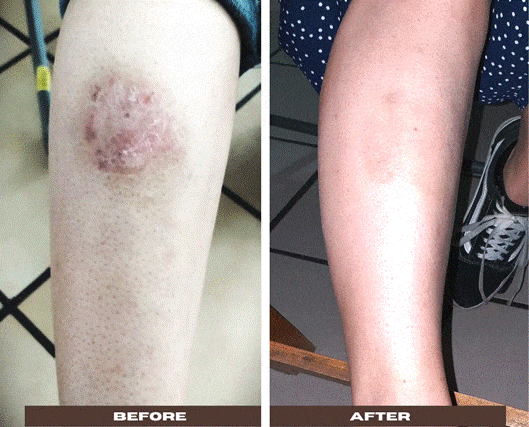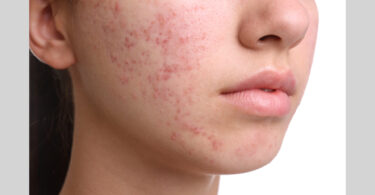Abstract
Psoriasis and is one of the most prevalent autoimmune chronic inflammatory skin diseases. For patients with moderate to severe plaque psoriasis, topical agents remain the mainstay of treatment, but on the other side for severe psoriasis, biological treatments with serious side effects are the main option.
Here we present a case of psoriasis in a 23-year-old female, who responded favorably to the homeopathic remedy “Lycopodium clavatum”. Her lesions disappeared in 9 months of treatment, after being active for 12 years. Larger studies are needed to determine the benefit from classical homeopathy in psoriasis.
Keywords: psoriasis; classical homeopathy; auto immunity.
Background
Psoriasis is a chronic inflammatory skin disease that develops in the background of a genetic inheritance. It is characterized by sharply demarcated erythematous plaques with a whitish scale1. Recent studies have shown that the pathogenesis of the disease is related substantially to TNF a, dendritic cells, and T-cells activity. There may also be related environmental triggers, such as beta-hemolytic streptococcal infections2.
Several clinical phenotypes of psoriasis are recognized, with chronic plaque (Psoriasis Vulgaris) accounting for 90% of cases. Comorbidities of psoriasis are attracting interest and include impairment of quality of life and associated depressive illness, cardiovascular disease, and seronegative arthritis known as psoriatic arthritis2.
The prevalence of psoriasis varies with the country, and psoriasis can appear at any age, suggesting that ethnicity, genetic background, and environmental factors affect its prevalence. Genetic factors play a significant role in the pathogenesis of psoriasis.
In genetically predisposed individuals, various triggering factors can elicit the disease. In past surveys from 1982 to 2012, the exacerbating factors for the Japanese population were observed to be stress (6.4% to 16.6%), seasonal factors (9.7% to 13.3%), infection (3.5% to 8.3%), sun exposure (1.3% to 3.5%), and β-blockers (0.9% to 2.3%)3.
The common comorbidities included hypertension (1.1% to 27.8%), diabetes mellitus (DM) (7.0% to 13.9%), cardiovascular diseases (4.2% to 8.1%), and tonsillitis (3.5% to 5.4%)3 .
For patients with mild psoriasis, topical agents remain the mainstay of treatment, and they include topical corticosteroids, vitamin D analogs, calcineurin inhibitors, and keratolytic. The American Academy of Dermatology-National Psoriasis Foundation guidelines recommends biologics as an option for first-line treatment of moderate to severe plaque psoriasis because of their efficacy in treating it and acceptable safety profiles. Specifically, TNF-α inhibitors include etanercept, adalimumab, certolizumab, and infliximab4.
Immunosuppression being the main idea behind conventional therapy, alternative therapies have been sought to overcome its shortcomings. Classical homeopathy has been extensively applied for psoriasis, with success5. We present another such case that can enrich this body of literature.
Case Report
Patient: Mexican female, 23 years old
Diagnosis: Psoriasis vulgaris.
Symptoms: Scaly spot on the right leg that increased over time, a scaly spot on the lips. on the right side.
Medication: Halcinonide and Fluocinolone creams (topical steroids)
The patient complained about a scaly spot on the right leg that increased over time, and a scaly spot on her lips on the right side. The psoriasis was present from birth and she had moments of exacerbation throughout her life. She had several stress factors over the last 2 years, including the COVID-19 and influenza vaccines.
The itching aggravated with heat and was better by cold. The spot on the lips was aggravated by drinking hot drinks and ameliorated by drinking cold beverages. The spots burned and were dry, with itching in stressful situations leading to scratching until she bled.
Another complaint was lack of energy in the morning, even though she sleeps 6-7 hours at night. Her menstruation was irregular and very painful. The patient also mentioned that she was always sick in her stomach, never able to feel quite right about eating because she was bloated or had loose stools. She had a strong desire for chocolate and sweets.
In the mental and emotional area, the patient complained about irritability, anxiety about not being in control of things, and anxiety about the future. She was afraid of the future, and fear of new situations. Usually had nightmares about her teeth or hair falling out, and the death of loved ones.
History revealed that she was born with a scaly spot on the face, scalp, and groin (all of them on the right side). The scaly spots on the scalp and head were present from birth to 6 years age. The one from the right groin was present from 6 to 12 years age. And the actual spot in the right leg is from 12 years age onwards.
The lesion on the lips is active since April 2020, after the COVID-19 vaccine. She had Hepatitis B at the age of 5 years, when she remembers bleeding from her ears.The doctors gave her a slim chance of survival. She was not sure if she still had liver-related complaints. She had high fever every one or two years, her last fever was after the COVID-19 vaccine in 2020.
Prescription on April 4th, 2021: The patient sought homeopathic consultation on April 4th, 2021. She stopped the ointments and creams used to control the itching and continued with the same routine she had been practicing. The homeopathic remedy Lycopodium clavatum LM1 was chosen to be given. The follow-up and subsequent prescriptions are shown in Table 1.
Logic Behind the prescription: As we see in Fig 1, the repertorization brought up Lycopodium and Bryonia alba as the most likely remedies. Lycopodium had the most predominant keynotes of the case, such as “Generalities – side – right”, “Stomach – distention”, and “Generalities – weakness – morning – waking on”. The desire for chocolate and sweets is also a keynote of “Sulphur”, and the main complaint which is the skin condition is also present in Sulphur, nevertheless the peculiarities indicated Lycopodium clavatum.
Level of Health Analysis: The patient had acutes with high fever every one or two years, with typical microorganisms, which puts her in the highest levels of health. In this kind of patient belonging to group A, though we can use higher potencies, I did not want to trigger an unnecessarily strong aggravation and sought to give LM potencies.
Figure 1: Repertorisation on the first visit
Figure 2: Evolution of psoriatic spot on the right leg with homeopathic treatment.
Figure 3: Evolution of lesion on the lip with homeopathic treatment.
Figure 4: Evolution of the right leg for 6 years before homeopathic treatment. The last marked aggravation was after the COVID-19 vaccine.
Table 1: Follow-up of the case
| Date | Symptoms | Prescription |
| May 14th, 2021 | Scaly spot on the lip became worse, she could not tolerate anything touching her lips except just cold water. The spot on the leg was itchier. Energy better. | Lycopodium LM1 daily. |
| June 12th, 2021
|
Spot on the lip is drier. Spot on the right leg stopped being wet and was dry. Menstrual cramps with intense pain. Menstruation appeared after 2 months | Lycopodium LM1 daily, and every 5 minutes in case of cramps. |
| August 13th, 2021 | The spot on the lip disappeared. The spot on the leg decreased in size. | Lycopodium LM1 |
| October 22nd, 2021 | Menses appeared at 35 days, with pain. Spot on the leg further decreased in size. Energy better. Mood better. | Lycopodium LM1 |
| November 21st, 2022 | Spot on the leg disappeared. Menses appeared at 30 days. | Lycopodium LM1 |
| December 21st,2022 | Mood better, energy better. No nightmares. Menstruation appeared at 32 days. | Null |
The last follow-up was on December 21st, 2022, the patient showed a marked improvement in psoriasis and comorbidities. According to the laws of homeopathy, we see the initial aggravation of the symptoms at the beginning of the treatment.
Both spots disappeared in a lapse of 9 months, after being active for 12 years. For the last 11 years, the psoriasis was active in periods of aggravation and improvement, but it had never completely disappeared. The complaints with her menses disappeared. The patient also showed an improvement in the emotional and mental plane and a better level of energy in her daily activities.
Discussion
Psoriasis is a chronic, systemic immune-mediated disease characterized by the development of erythematous, indurated, scaly, pruritic, and often painful skin plaques. Psoriasis pathogenesis is driven by proinflammatory cytokines and psoriasis is associated with increased risk for comorbidities, including, but not limited to, psoriatic arthritis, cardiovascular disease, diabetes mellitus, obesity, inflammatory bowel disease, and nonalcoholic fatty liver disease compared with general population. In moderate to severe psoriasis, elevated levels of multiple proinflammatory cytokines are found not only in skin lesions but also in the blood4.
According to Osmancevic et al, the mainstay in the treatment of psoriasis is the biologicals, but it must be remembered that biologicals in principle, involve an impact on the immune system and that there are potential risks, above all the risk of infections.
Individually adapted, so-called patient-centered care is essential for the effective treatment of psoriasis and related co-morbidities. Individualized care for psoriasis includes a better understanding of skin symptoms, physical and mental comorbidity, the disease’s impact on quality of life, treatment, and prevention, as well as a good relationship between patient and doctor, increased involvement of family and friends, and patient education about the disease and the treatment strategy7.
This pathology often progresses to psoriatic arthritis, making the long-term effects in patients with a diagnosis of psoriasis and conventional treatment overwhelming. A comprehensive therapeutic approach is therefore necessary.
Conclusions
In the case presented, the patient responded favourably to the homeopathic remedy “Lycopodium clavatum” prescribed accordingly to the laws and rules of classical homeopathy. The homeopathic treatment took 9 months, unlike conventional medicine, which offers a lifelong treatment with side effects.
At the end of the treatment, the patient remained free of symptoms without the need for adjuvant therapies. Further research is needed to evaluate the effectiveness of classical homeopathy in psoriasis.
References
- Kamiya, Koji, Megumi Kishimoto, Junichi Sugai, Mayumi Komine, and Mamitaro Ohtsuki. 2019. “Risk Factors for the Development of Psoriasis.” International Journal of Molecular Sciences 20 (18). https://doi.org/3390/ijms20184347.
- Griffiths, Christopher Em, and Jonathan Nwn Barker. 2020. “Pathogenesis and Clinical Features of Psoriasis.” The Lancet 370 (9583): 263–71.
- Sagoo, Gurdeep S., Rachid Tazi-Ahnini, Jonathan W. N. Barker, James T. Elder, Rajan P. Nair, Lena Samuelsson, Heiko Traupe, Richard C. Trembath, Darren A. Robinson, and Mark M. Iles. 2021. “Meta-Analysis of Genome-Wide Studies of Psoriasis Susceptibility Reveals Linkage to Chromosomes 6p21 and 4q28–q31 in Caucasian and Chinese Hans Population.” The Journal of Investigative Dermatology 122 (6): 1401–5.
- Armstrong, April W., and Charlotte Read. 2020. “Pathophysiology, Clinical Presentation, and Treatment of Psoriasis: A Review.” JAMA: The Journal of the American Medical Association 323 (19): 1945–60.
- Mahesh S, Shah V, Mallappa M, Vithoulkas G. Psoriasis cases of same diagnosis but different phenotypes—Management through individualized homeopathic therapy. Clinical Case Reports. 2019 Aug;7(8):1499-507.
- Korman, N. J. 2020. “Management of Psoriasis as a Systemic Disease: What Is the Evidence?” The British Journal of Dermatology 182 (4): 840–48.
- Osmancevic, Amra, and Mona Ståhle. 2019. “[Treatment of psoriasis: before and now].” Lakartidningen 114 (November). https://www.ncbi.nlm.nih.gov/pubmed/29292946.










Great achievement, Maria Fernanda. Congratulations to you and to Homeopathy!